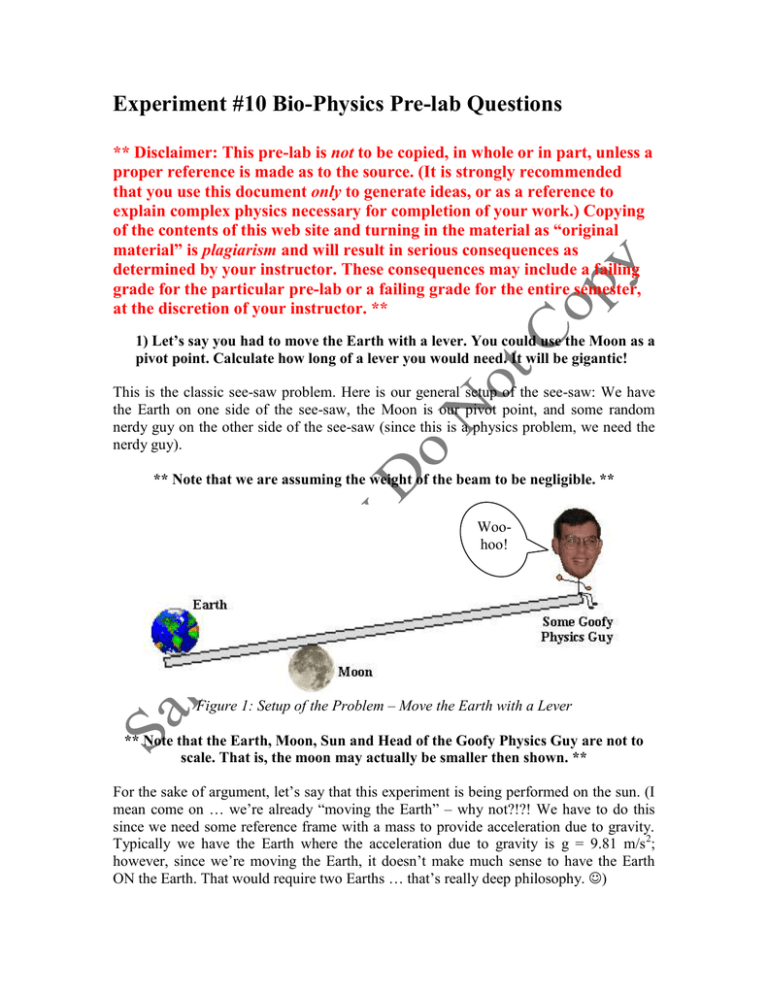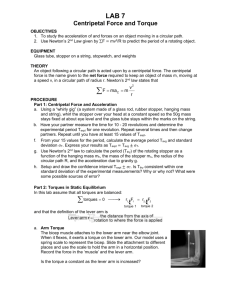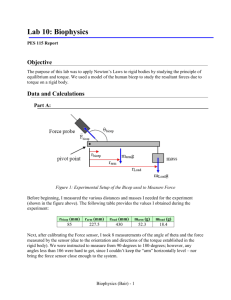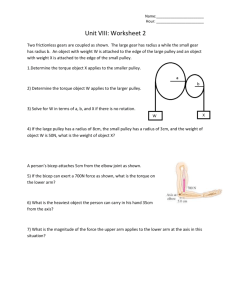Experiment #10 Bio-Physics Pre-lab Questions
advertisement

Experiment #10 Bio-Physics Pre-lab Questions ** Disclaimer: This pre-lab is not to be copied, in whole or in part, unless a proper reference is made as to the source. (It is strongly recommended that you use this document only to generate ideas, or as a reference to explain complex physics necessary for completion of your work.) Copying of the contents of this web site and turning in the material as “original material” is plagiarism and will result in serious consequences as determined by your instructor. These consequences may include a failing grade for the particular pre-lab or a failing grade for the entire semester, at the discretion of your instructor. ** 1) Let’s say you had to move the Earth with a lever. You could use the Moon as a pivot point. Calculate how long of a lever you would need. It will be gigantic! This is the classic see-saw problem. Here is our general setup of the see-saw: We have the Earth on one side of the see-saw, the Moon is our pivot point, and some random nerdy guy on the other side of the see-saw (since this is a physics problem, we need the nerdy guy). ** Note that we are assuming the weight of the beam to be negligible. ** Woohoo! Figure 1: Setup of the Problem – Move the Earth with a Lever ** Note that the Earth, Moon, Sun and Head of the Goofy Physics Guy are not to scale. That is, the moon may actually be smaller then shown. ** For the sake of argument, let’s say that this experiment is being performed on the sun. (I mean come on … we’re already “moving the Earth” – why not?!?! We have to do this since we need some reference frame with a mass to provide acceleration due to gravity. Typically we have the Earth where the acceleration due to gravity is g = 9.81 m/s 2; however, since we’re moving the Earth, it doesn’t make much sense to have the Earth ON the Earth. That would require two Earths … that’s really deep philosophy. ) We’ll call the acceleration due to gravity on the sun, gsun. If we draw in the various forces and distances, we get the following setup: Figure 2: Experimental Setup on Solar Reference Frame Some parameters which may be useful for solving this problem were given: Force due to Mass of the Earth and Acceleration due to Gravity on the Sun (N) 5.86 x 1025 Distance to the Moon (km) 384000 Force due to Mass of Some Goofy Physics Guy and Acceleration due to Gravity on the Sun (N) 1000 What we are first trying to find is what is the minimum length that Bill must be from the Moon in order to start to move the Earth. That is, we want the torque created by Bill to be greater then the torque created by the Earth. Earth Bill We know the definition of magnitude of the torque is given by: rF sin We’re going to assume that the angles between the forces and the lever arms are all nearly 90 degrees, because that makes the math A LOT EASIER. (They may in actuality be like 89.99999999999999 degrees, but that’s close enough to 90 degrees.) rF sin 90 o rF Thus: Earth rEarth FEarth and Bill rBill FBill Examining the original inequality: rEarth FEarth rBill FBill Thus, the minimum distance Bill must be away from the moon is: rBill rEarth FEarth FBill Plugging in the values we were given produces the following: rBill 384000 km5.86 10 24 1000 N N rBill 2.25024 10 28 km So, in order to “lift” the earth with just his own body weight, Bill must have a lever arm of at least 2.25024 x 1028 kilometers! (Notice this is only Bill’s lever arm, not the entire length of the lever.) To get a “prettier” number, let’s convert this value to light-years. (Notice that “light-years” is a weird name for a distance, but IT IS a distance. It is the distance light takes to travel one year. That is, if I created a beam of light right this second, in one year [2007] it would be a distance of 1 light-year away from my current location.) The conversion factor for kilometers to light-years is: 1 ly 9.46 1012 km 1 ly 2.378689 1015 ly 2.25024 10 28 km 12 9 . 46 10 km rBill 2.378689 1015 ly So the minimum length of Bill’s lever arm must be at least 2,278,689,000,000,000 lightyears long. Needless to say, that’s a long distance. So if we created a beam of light right this second, it would get there in November of the year 2278689000002006. Now, to answer the actual question: How long of a lever you would need? The total length of the lever will be the length of the Earth’s radial arm and Bill’s radial arm summed together. LeverLength rEarth rBill LeverLength 384000 km 2.25024 10 28 km LeverLength 2.2502400000000000000000384000 10 28 km LeverLength 2.378689 1015 ly So, you can see that the majority of the length of the entire lever is due to the side that Bill is sitting on. In conclusion: For all you crazy people that want to single-handedly move the Earth with a giant lever that has the Moon as its pivot point … just “fah-getta-bout-it”. 2) Use the following parameters and the experimental setup to calculate values for Fbicep given that: rbicep (cm) 10 rarm (cm) 25 rload (cm) 60 marm (g) 45 mload (g) 20 Figure 3: Experimental Setup of a Bicep Supporting a Massive Load In the setup above, there are three torques (recall that a torque is force acting at a radial arm): 1. [ load ] = The load mass hanging (force) at the end of the length (radial arm). 2. [ bicep ] = The bicep holding (force) the length straight (radial arm). 3. [ arm ] = The mass of the length itself hanging (force) at the center of mass (radial arm). For static equilibrium (where nothing is rotating/moving) the net sum of the torques acting on the system must add up to zero. (Remember we use the greek letter “tao” for torque.) n i 1 i 0 So, for our system, we have three torques; so, for static equilibrium, we must have: 3 i 1 i 1 2 3 load bicep arm 0 For this experiment, we will always force (no pun intended) the “arm” to be level (again no pun intended). That is, we want the arm to be perfectly parallel horizontally with the table. This will greatly simplify the calculation for the torques due to the load and the arm. If we explicitly write out each of the three torques: Torque 1 (due to load): First, recall the definition of torque: load rload Fload To find the direction of the torque, we need to use the right-hand rule. First point your fingers in the direction of rload then curl them to the direction of Fload. The direction your thumb points is the direction of the torque for the cross product. For this case, rload is pointing to the right (so point your pointer-to-pinky fingers in the right direction), and Fload is pointing down (keeping your fingers in the right direction, twist your hand (palm down) so when you bend your fingers they are pointing down. Your thumb should be pointing away from you. This means that the direction of the rotation is clockwise (nod your hand up and down while keeping your thumb pointing away from you and you’ll see that the direction from your knuckles to your finger tips is in the clockwise direction) and the sign of the torque is negative). ** Aside ** I can never remember the “righty-tighty, lefty-loosy” thing my dad taught me for screws, especially when I’m on by back. When I want to know which way I want the screw to go, I simply use the direction of torque (because that’s exactly what I’m doing). If I want the screw to go away from me, I point my thumb in that direction and see that the rotation direction from my knuckles to my finger tips is in the clockwise direction. If I want the screw to go toward me, I point my thumb in that direction and see that the rotation direction from my knuckles to my finger tips is in the counter-clockwise direction. ** End Aside ** By the right-hand rule: load rload Fload sin load And since the angle (by design) between the force and the lever arm is 90 degrees: load rload Fload Torque 2 (due to bicep): To find the direction of this torque, rbicep is pointing to the right (so point your pointer-topinky fingers in the right direction), and Fbicep is pointing leftish-up (keeping your fingers in the right direction, twist your hand (palm up) so when you bend your fingers they are pointing backwards. Your thumb should be pointing toward you. This means that the direction of the rotation is counter-clockwise (nod your hand up and down while keeping your thumb pointing toward you and you’ll see that the direction from your knuckles to your finger tips is in the counter-clockwise direction) and the sign of the torque is positive). By the right-hand rule: bicep rbicep Fbicep sin bicep Torque 3 (due to arm): To find the direction of this torque, rarm is pointing to the right (so point your pointer-topinky fingers in the right direction), and Farm is pointing down (keeping your fingers in the right direction, twist your hand (palm down) so when you bend your fingers they are pointing down. Your thumb should be pointing away from you. This means that the direction of the rotation is clockwise and the sign of the torque is negative). By the right-hand rule: arm rarm Farm sin arm And since the angle (by design) between the force and the lever arm is 90 degrees: arm rarm Farm Bringing it all together: Now, if we add each of these up and set their sum equal to zero, we have the static equilibrium equation: 3 i 1 i load bicep arm 0 rload Fload rbicep Fbicep sin bicep rarmFarm 0 rload Fload rbicep Fbicep sin bicep rarm Farm 0 Solve this for the force acting on the bicep. Fbicep rload Fload rarm Farm rload mload g rarmmarm g rbicep sin bicep rbicep sin bicep Fbicep rload mload g rarmmarm g rbicep sin bicep We are given the distances and the masses, and we know the acceleration due to gravity; so, for any give theta we can calculate the force on the bicep. rbicep (cm) 10 rarm (cm) 25 rload (cm) 60 marm (g) 45 mload (g) 20 First though, we need to convert all the distances to meters and all the masses to kilograms: rbicep (m) 0.10 rarm (m) 0.25 rload (m) 0.60 marm (kg) 0.045 mload (kg) 0.020 o Calculate Fbicep for θ = 90° Fbicep Fbicep rload mload g rarmmarm g rbicep sin bicep 0.6 m0.02 kg 9.81 m2 0.25 m0.045 kg 9.81 m2 s 0.1msin 90 o Fbicep 2.280825 N o Calculate Fbicep for θ = 45° s Fbicep 0.6 m0.02 kg 9.81 m2 0.25 m0.045 kg 9.81 m2 s 0.1 msin 45o s Fbicep 3.22557 N o Calculate Fbicep for θ = 160° Fbicep 0.6 m0.02 kg 9.81 m2 0.25 m0.045 kg 9.81 m2 s 0.1msin 160 o Fbicep 6.66869 N s






